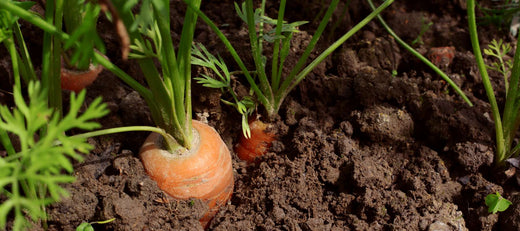Carrots have a reputation for being tricky to grow, but they are a highly worthwhile addition to any survival garden. They can be planted in succession for harvest throughout most of the year. They are easy to store and preserve, and they are a nutritious and tasty addition to salads, soups, stews, and desserts. Once you understand the needs of the carrot, they become much easier to grow.
What Carrot Plants Need
To successfully germinate, carrots need:
- Rock-free, loose soil that does not have too much nitrogen
- Consistent moisture
- Temperatures between 40 and 80 degrees Fahrenheit (cooler is better)
- Space in the garden with room to grow
Once seedlings are established, carrots need steady moisture and lots of sunshine.
Planting Carrots

Carrot seeds can be planted directly in the garden 3 to 4 weeks prior to your last frost date as long as the soil can be worked. Typical of most root vegetables, carrots do not transplant well, so direct sowing is the preferred method. Seeds will not germinate if temperatures are above 80 degrees, so keep that in mind when succession planting later in the year. For a continuous harvest, plant new seeds every 3 weeks in the early Spring and Fall.
Before sowing any carrot seeds, you should prepare the soil. Your soil should be loose and free of rocks. If you have hard, clay soil, mix in lots of organic matter, like compost, and loosen the soil down about 8 to 10 inches. Carrots prefer a neutral soil pH between 6.0 and 7.0. You might also want to add some bone meal to the soil, which increases phosphorous levels to encourage strong root growth. Avoid nitrogen fertilizers as those will cause carrots to have lots of leaves but not put energy into growing the root
.Water your soil well before sowing seeds. Because carrot seeds should only be sown about 1/8 - 1/4 inch deep, they could be washed away if you water after sowing. Lay out your rows by digging shallow trenches about 1 to 2 inches apart. The individual seeds should be planted 2 to 3 inches apart. Since carrot seeds are so tiny, one trick for correctly spacing seeds is to make seed tape with some toilet paper and paste made with flour and water. Just barely cover seeds with sifted soil or compost.

We have found the most success by covering the rows of seeds with garden fabric that will allow water to penetrate and water frequently. The covering serves several purposes. It helps provide a little additional warmth to speed germination, holds in moisture, and also prevents birds and other animals from eating the seeds. Most carrots take 2 to 3 weeks to germinate. Once you see sprouts, you can remove the fabric.
Growing Carrots
Once your seedlings start to grow, you’ll want to thin them to 2 to 3 inches apart. It is best to simply snip off the plants you don’t want with scissors, rather than pull them which can disturb the neighbors you want to keep. After thinning, spread some organic mulch around the seedlings to help retain moisture.
Carrots require 6 to 8 hours of bright sun to grow properly, but they can tolerate some light shade. Growing carrots need about 1 inch of water a week. Keep the soil moist, and never soggy. You can use a low-nitrogen fertilizer every 5 to 6 weeks.
Carrots can be vulnerable to the carrot rust fly which will cause wilted leaves and can put holes in the roots. Interplanting your carrots with alliums like garlic or onions is a great way to deter carrot flies. Row covers can also help prevent pests.
Harvesting Carrots

Carrots are usually ready to harvest in about 60 days after planting. This will vary depending on the variety and your climate. It also depends on whether you want baby carrots or larger, more developed carrots. Ideally, they should be at least the width of your thumb, about 1/2 inch in diameter.
Small carrots can usually be harvested by simply gathering their leaves and gently twisting them out of the soil. Larger carrots might need the surrounding soil loosened a bit with a spade or garden fork.
Don’t feel like you need to harvest all of your carrots at once. You can allow them to mature over the course of several weeks. Fall carrots are sweetest once they’ve experienced a light frost.
Storing Carrots
Fresh carrots will last in the fridge for up to 4 weeks. To extend their life a little longer, you can cut off all but about 1/2 inch of stem, rinse the roots, and put them in a zip-top bag or plastic container. They can be stored in a root cellar by placing them in some lightly moistened sand.
When not used fresh in a recipe like Carrot Halwa, carrots are often pickled, fermented, or canned for more long-term storage. They also store well frozen if they are cut and blanched first.
Don’t forget about the carrot tops! Carrot leaves are edible and make a great addition to salad and even make a tasty pesto.
Try Them, You’ll Like Them
Carrots come in a rainbow of colors and sizes. Some of our favorites include Imperator 58 Carrots, an AAS Award Winner, and our colorful Rainbow Carrot Blend. You can try 6 different varieties of heirloom carrots with our Carrot Seed Collection.
Fresh carrots from your garden taste nothing like the ones from your grocery store. They are packed with flavor and nutrients and store well. Once you know the proper method, growing carrots from seed allows you the opportunity to try different varieties and reap the flavorful rewards.
























